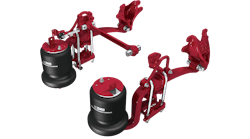With the Commercial Vehicle Safety Alliance (CVSA) Brake Safety Week campaign taking place September 7-13, Bendix Commercial Vehicle Systems LLC is aiming to help truck fleets, drivers, and technicians get ready for the annual inspections.
The CVSA effort--also known as Operation Airbrake--is an annual outreach and enforcement campaign designed to improve commercial vehicle brake safety throughout North America. More than 3.4 million brakes have been inspected since the program began in 1998, and teams of CVSA-certified inspectors are expected to conduct more than 30,000 roadside checks of commercial vehicles and their drivers during Brake Safety Week 2014.
“Regular, thorough vehicle maintenance--including using replacement parts designed to meet or exceed today’s regulations--along with pre-trip inspection practices, are a vital part of improving roadway safety, and Bendix shares CVSA’s commitment to promoting their importance,” says Fred Andersky, Bendix director of government and industry affairs. “The upkeep and training practices emphasized during Operation Airbrake need to be part of everyone’s year-round planning and operations.”
Operation Airbrake targets the following items for inspection: driver’s license, registration, low-air warning device, pushrod travel (brake adjustment), brake linings/drums, leaks/air loss rate, and tractor protection system.
To help prepare for these inspections, Bendix experts offer five things fleets, drivers, and technicians need to know for Brake Safety Week:
• What to do with an out-of-adjustment brake stroke. Wheel-ends beyond the maximum allowable brake stroke are considered out of adjustment, and drivers can incur fines if 25% of a truck’s wheel-ends are out of adjustment. The most crucial advice for fleets and drivers operating vehicles with automatic slack adjusters is not to manually adjust the ASA if the brake is beyond the stroke limit. Several factors can cause a brake stroke to exceed the maximum allowable value, including improper lubrication of the camshaft, cam tube, and clevis pins; or excessive wear of the cam head, bushings, and rollers. None of these are fixed by manual readjustment of an automatic slack adjuster.
• How to keep the air system clean. Contamination--and oil, in particular--can contribute to premature damage of key components such as brake modulating valves and brake chamber diaphragms. And oil-deteriorated seals can cause air system leaks, which are a target of Operation Airbrake inspections. Monthly checks for moisture in the air brake system, along with installation and regular replacement of oil-coalescing air dryer cartridges will help ensure proper operation of the air brake system.
• How to read and address fault codes. A commercial vehicle’s dashboard ABS (Anti-lock Braking System) warning lamp conveys information on problems with the ABS system, such as wheel speed sensors, while the traction control/stability control lamp provides information regarding the traction control and stability systems (if the vehicle is equipped with these systems). The blinking light fault codes for both systems are accessed using the dashboard diagnostic switch or a remote diagnostic unit. By referring to the fault code information in the service data sheet, a driver or technician can pinpoint and repair specific sensor issues.
• How to conduct effective visual inspections. Pre-trip inspections are the first level of vehicle maintenance and are essential to brake system safety and performance. Drivers should walk around the vehicle and look for obvious problems such as loose hoses and leaks, and check air disc brake rotors for cracks. For drum brakes without dust shields installed, this is a good opportunity to check the lining wear, which can be done without removing the wheel. It’s not necessary to get under the vehicle before every trip; once or twice a week should suffice.
• The condition and quality of brake friction. Inspect brake linings for thickness, cracks, and wear--all of which affect stopping power and CSA scores.
“Bendix recommends that fleets become familiar with TMC/ATA Recommended Practice 627A (RP 627A), which provides out-of-service criteria for both air disc and foundation drum brakes,” said Gary Ganaway, director of marketing and global customer solutions at Bendix Spicer Foundation Brake (BSFB), a joint venture of Bendix Commercial Vehicle Systems LLC and Dana Commercial Vehicle Products LLC. “RP 627A aligns directly with CVSA inspection guidelines and provides good visual illustrations for both acceptable and out-of-service conditions.”








